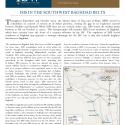 |
 |
ISIS in the Southwest Baghdad Belts

Throughout September and October 2014, the Islamic State of Iraq and al-Sham (ISIS) moved to consolidate its control of terrain in al-Anbar province, closing the gap in its Euphrates control between Haditha and Ramadi. While ISIS does not yet control either city, ISIS seized the midway point between at Hit on October 2, 2014. This backgrounder will examine ISIS forces southwest of Baghdad, which have recently been the focus of a counter-offensive by the ISF. The expulsion of ISIS forces southwest of Baghdad may generate a strategic advantage for the ISF; but it may also initially heighten the threat to Baghdad.
The southwestern Baghdad Belts have been an ISIS stronghold for some time. ISIS reestablished itself in 2013 within the historic “Triangle of Death” comprised of a cluster of cities 20 km south of Baghdad, including Mahmudiyah, Latifiyah, and Yusifiyah. Shi’a militia groups have had control of these areas since 2013, whereas ISIS has been present in the countryside, particularly in the Karaghuli tribal areas, including Jurf al-Sakhar. ISIS presence in this area allowed the group to launch VBIED attacks in southwestern Baghdad in 2013, as well as to project influence over populated areas to the west in Anbar province.
These towns, including Jurf al-Sakhar, Farisiyah, Fadhiliyah, Abu Ghraib, and Amiriyat al-Fallujah, link ISIS in northern Babil with ISIS in Anbar. ISIS likely established a dominant presence in this area after the Abu Ghraib prison break in July 2013. ISIS announced this support zone in early 2014 through the establishment of a Twitter account for its “Wilayat Janoob,” or “southern” governorate which extends from southwestern Baghdad, towards northern Babil to the south, and west towards Amiriyat al-Fallujah on the other side of the Euphrates in Anbar province. From this zone, ISIS can project force not only upon Anbar, but also Babil, Karbala, and Baghdad.
This ISIS stronghold came under attack by the ISF and Shi’a militias in October 2014. Jurf al-Sakhar is now controlled by the ISF and Iraqi Shi’a militias as of October 24, 2014. ISIS has launched multiple attacks to seize Amiriyat al-Fallujah since the beginning of the Anbar clashes in late 2013. So far, however, these attacks have been repelled by the Iraqi Army (IA), Iraqi Police (IP), and Iraqi Sunni anti-ISIS tribes stationed in the sub-district. As of November 20, the anti-ISIS forces in the area have switched from defensive to offensive posture by launching an operation to clear the southern environs of the area.
Given the significance of this terrain to ISIS, it is necessary to estimate the remaining strength of ISIS forces between south of Amiriyat al-Fallujah and northern Babil. It is unclear at this time whether ISIS attacks on Amiriyat al-Fallujah in April 2014 were purely defensive measures to protect Fallujah, or whether they were offensive measures to consolidate territory in the northern “outer” ring. Closer examination of ISIS activities from January 2014 to October 2014 reveal that there are separate ISIS subsystems within this southwest quadrant of the Baghdad Belts, forming an “Inner Ring” and an “Outer Ring,” which will likely react to the ISF clearing operations differently.